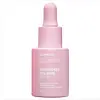What's inside
What's inside
 Key Ingredients
Key Ingredients

 Benefits
Benefits

 Concerns
Concerns

No concerns
 Ingredients Side-by-side
Ingredients Side-by-side

Water
Skin ConditioningSaccharide Isomerate
HumectantPentylene Glycol
Skin ConditioningSchizophyllan
HumectantNiacinamide
SmoothingOryza Sativa Bran Oil
EmollientAlpha-Arbutin
AntioxidantEthylhexylglycerin
Skin ConditioningGalactomyces Ferment Filtrate
HumectantGlycerin
HumectantButylene Glycol
HumectantPhenoxyethanol
PreservativeCeramide NP
Skin ConditioningGlyceryl Polyacrylate
Caprylyl Glycol
EmollientSodium Hyaluronate
HumectantPullulan
Disodium Phosphate
BufferingPotassium Phosphate
BufferingHydrolyzed Conchiolin Protein
Skin ConditioningDipotassium Glycyrrhizate
HumectantPanthenol
Skin ConditioningAsiaticoside
AntioxidantAsiatic Acid
Skin ConditioningMadecassic Acid
Skin ConditioningBisabolol
MaskingResveratrol
AntioxidantHyaluronic Acid
HumectantGlycyrrhiza Glabra Root Extract
BleachingAcetyl Glucosamine
Skin ConditioningHydrolyzed Royal Jelly Protein
Skin ConditioningCarbomer
Emulsion StabilisingAllantoin
Skin ConditioningXanthan Gum
EmulsifyingWater, Saccharide Isomerate, Pentylene Glycol, Schizophyllan, Niacinamide, Oryza Sativa Bran Oil, Alpha-Arbutin, Ethylhexylglycerin, Galactomyces Ferment Filtrate, Glycerin, Butylene Glycol, Phenoxyethanol, Ceramide NP, Glyceryl Polyacrylate, Caprylyl Glycol, Sodium Hyaluronate, Pullulan, Disodium Phosphate, Potassium Phosphate, Hydrolyzed Conchiolin Protein, Dipotassium Glycyrrhizate, Panthenol, Asiaticoside, Asiatic Acid, Madecassic Acid, Bisabolol, Resveratrol, Hyaluronic Acid, Glycyrrhiza Glabra Root Extract, Acetyl Glucosamine, Hydrolyzed Royal Jelly Protein, Carbomer, Allantoin, Xanthan Gum
Water
Skin ConditioningParaffinum Liquidum
EmollientNiacinamide
SmoothingPropylene Glycol
HumectantSorbitol
HumectantSodium Hyaluronate
HumectantErythritol
HumectantHamamelis Virginiana Extract
AntiseborrhoeicSodium Acrylate/Sodium Acryloyldimethyl Taurate Copolymer
Emulsion StabilisingCeramide Ns
Skin ConditioningCeramide NP
Skin ConditioningCeramide Ng
Skin ConditioningCeramide Eos
Skin ConditioningCeramide EOP
Skin ConditioningCeramide As
Skin ConditioningCeramide AP
Skin ConditioningAllantoin
Skin ConditioningGlyceryl Glucoside
HumectantHydroxyacetophenone
AntioxidantCaprylhydroxamic Acid
Calendula Officinalis Flower Extract
MaskingCarbomer
Emulsion StabilisingTriethanolamine
BufferingCentella Asiatica Extract
CleansingCitrus Reticulata Fruit Extract
Skin ProtectingSalicylic Acid
MaskingUbiquinone
AntioxidantCitrus Medica Limonum Peel Extract
EmollientTocopherol
AntioxidantSaccharomyces/Rice Ferment Filtrate
Skin ConditioningLactococcus Ferment
Skin ConditioningGlucose
HumectantWater, Paraffinum Liquidum, Niacinamide, Propylene Glycol, Sorbitol, Sodium Hyaluronate, Erythritol, Hamamelis Virginiana Extract, Sodium Acrylate/Sodium Acryloyldimethyl Taurate Copolymer, Ceramide Ns, Ceramide NP, Ceramide Ng, Ceramide Eos, Ceramide EOP, Ceramide As, Ceramide AP, Allantoin, Glyceryl Glucoside, Hydroxyacetophenone, Caprylhydroxamic Acid, Calendula Officinalis Flower Extract, Carbomer, Triethanolamine, Centella Asiatica Extract, Citrus Reticulata Fruit Extract, Salicylic Acid, Ubiquinone, Citrus Medica Limonum Peel Extract, Tocopherol, Saccharomyces/Rice Ferment Filtrate, Lactococcus Ferment, Glucose
Ingredients Explained
These ingredients are found in both products.
Ingredients higher up in an ingredient list are typically present in a larger amount.
Allantoin is a soothing ingredient known for its protective and moisturizingg properties. Because of this, it is often added to products with strong active ingredients.
Studies show higher concentrations of this ingredient can promote wound healing.
Though it can be derived from the comfrey plant, allantoin is produced synthetically for cosmetic products to ensure purity.
Learn more about AllantoinCarbomer is a polymer of acrylic acid. Its main role is to create a gel consistency.
A high amount of carbomer can cause pilling or balling up of products. Don't worry, most products contain 1% or less of carbomer.
Ceramide NP is a type of ceramide.
Ceramides are intercellular lipids naturally found in our skin that bonds dead skin cells together to create a barrier. They are known for their ability to hold water and thus are a great ingredient for dry skin.
Ceramides are an important building block for our skin barrier. A stronger barrier helps the skin look more firm and hydrated. By bolstering the skin ceramides act as a barrier against irritating ingredients. This can help with inflammation as well.
If you would like to eat ceramides, sweet potatoes contain a small amount.
Read more about other common types of ceramides here:
Ceramide AP
Ceramide EOP
Niacinamide is a multitasking form of vitamin B3 that strengthens the skin barrier, reduces pores and dark spots, regulates oil, and improves signs of aging.
And the best part? It's gentle and well-tolerated by most skin types, including sensitive and reactive skin.
You might have heard of "niacin flush", or the reddening of skin that causes itchiness. Niacinamide has not been found to cause this.
In very rare cases, some individuals may not be able to tolerate niacinamide at all or experience an allergic reaction to it.
If you are experiencing flaking, irritation, and dryness with this ingredient, be sure to double check all your products as this ingredient can be found in all categories of skincare.
When incorporating niacinamide into your routine, look out for concentration amounts. Typically, 5% niacinamide provides benefits such as fading dark spots. However, if you have sensitive skin, it is better to begin with a smaller concentration.
When you apply niacinamide to your skin, your body converts it into nicotinamide adenine dinucleotide (NAD). NAD is an essential coenzyme that is already found in your cells as "fuel" and powers countless biological processes.
In your skin, NAD helps repair cell damage, produce new healthy cells, support collagen production, strengthen the skin barrier, and fight environmental stressors (like UV and pollution).
Our natural NAD levels start to decline with age, leading to slower skin repair, visible aging, and a weaker skin barrier. By providing your skin niacinamide, you're recharging your skin's NAD levels. This leads to stronger, healthier, and younger looking skin.
Another name for vitamin B3 is nicotinamide. This vitamin is water-soluble and our bodies don't store it. We obtain Vitamin B3 from either food or skincare. Meat, fish, wheat, yeast, and leafy greens contain vitamin B3.
The type of niacinamide used in skincare is synthetically created.
Learn more about NiacinamideSodium Hyaluronate is hyaluronic acid's salt form. It is commonly derived from the sodium salt of hyaluronic acid.
Like hyaluronic acid, it is great at holding water and acts as a humectant. This makes it a great skin hydrating ingredient.
Sodium Hyaluronate is naturally occurring in our bodies and is mostly found in eye fluid and joints.
These are some other common types of Hyaluronic Acid:
Learn more about Sodium HyaluronateWater. It's the most common cosmetic ingredient of all. You'll usually see it at the top of ingredient lists, meaning that it makes up the largest part of the product.
So why is it so popular? Water most often acts as a solvent - this means that it helps dissolve other ingredients into the formulation.
You'll also recognize water as that liquid we all need to stay alive. If you see this, drink a glass of water. Stay hydrated!
Learn more about Water